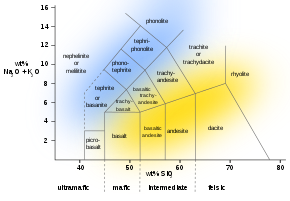
Back صخر نابط Arabic বহিঃজ শিলা Bengali/Bangla Purskekivim Estonian سنگ بیرونی Persian Ekstrusiivikivi Finnish बहिर्भेदी शैल Hindi Ekstrizif HT ექსტრუზია Georgian Экструзивті тау жыныстары Kazakh ബാഹ്യാഗ്നേയ ശില Malayalam


Extrusive rock refers to the mode of igneous volcanic rock formation in which hot magma from inside the Earth flows out (extrudes) onto the surface as lava or explodes violently into the atmosphere to fall back as pyroclastics or tuff.[1] In contrast, intrusive rock refers to rocks formed by magma which cools below the surface.[2]
The main effect of extrusion is that the magma can cool much more quickly in the open air or under seawater, and there is little time for the growth of crystals.[3] Sometimes, a residual portion of the matrix fails to crystallize at all, instead becoming a natural glass like obsidian.
If the magma contains abundant volatile components which are released as free gas, then it may cool with large or small vesicles (bubble-shaped cavities) such as in pumice, scoria, or vesicular basalt. Other examples of extrusive rocks are rhyolite and andesite.
- ^ "Extrusive rock - geology". Retrieved 21 October 2018.
- ^ Jain, Sreepat (2014). Fundamentals of Physical Geology. New Delhi, India: Springer. ISBN 9788132215394.
- ^ Cite error: The named reference
:0was invoked but never defined (see the help page).